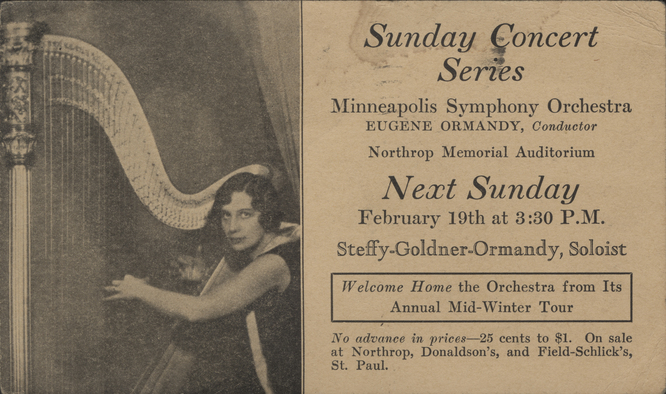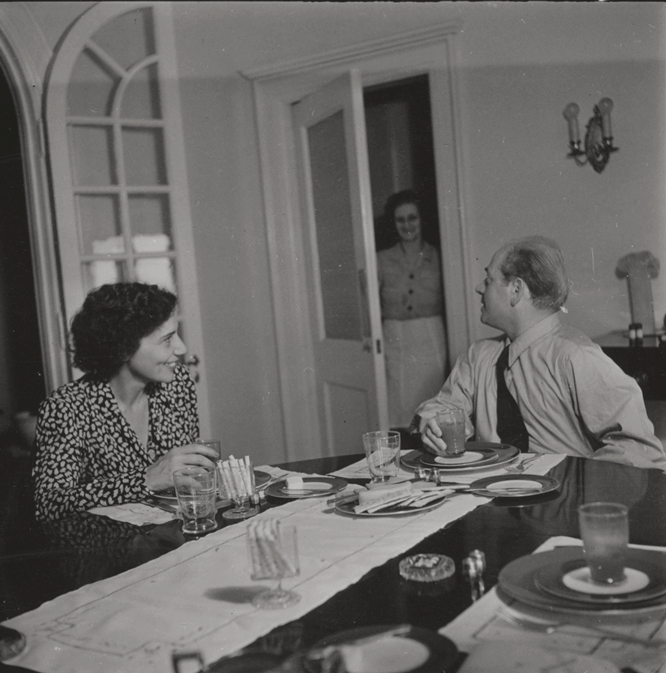Post-New York Philharmonic (1932-1962)
In 1931, Ormandy's conducting career took off when he stepped in as a last-minute substitute for Arturo Toscanini with the Philadelphia Orchestra, leading to his appointment as principal conductor of the Minnesota Orchestra that same year. Goldner resigned her position in order to move to Minneapolis with Ormandy in 1932, giving up her orchestral career in support of her husband. Glimpses of their first house together at 1801 Dupont Avenue South in Minneapolis are captured in Ormandy home videos acquired from the University of Pennsylvania Kislak Center for Special Collections.

The couple relocated to Philadelphia when Ormandy was hired at The Philadelphia Orchestra in 1936, beginning what would become one of the longest music director tenures at any major ensemble.
Goldner’s niece, Hanni Forrester, recalled how her aunt “played a big part in Ormandy’s life, keeping him organized and happy, dutifully supplying a dry shirt and orange juices at concert intermissions.” [3] Her musical acumen also did not go to waste:
"She was very much a critic of his in the early days. I remember how, after we would have a rehearsal or we had a performance, she was the first one to come back and tell him what was wrong. She was very valuable in the beginning, because she was a keen musician and she was Toscanini-trained, and [Eugene] respected Toscanini above all others."
– Sol Schoenbach, Principal bassoonist with the Philadelphia Orchestra [4]
Additional home movies and pictures exist from in the 1930s-1940s when Goldner and Ormandy frequently visited Europe for Ormandy's conducting engagements and family in Hungary and Germany.
By the late 1930s, Ormandy now had ample finances and social resources from his posts in Minneapolis and Philadelphia. In 1937, just before the Anschluss, he used his influence to bring Goldner's extended Jewish family from Austria to the United States. Ormandy set up a safe house in Strobl, along Lake Wolfgang near Salzburg, where family and friends resided while Ormandy secured travel documents and affidavits.
Upon immigrating to the United States, Goldner's family resided with the couple in a rented home in Wynnewood, Pennsylvania and, in 1943, moved to Gladwyne in which they nicknamed the house, "The Journey's End." In both locations, the Maestro hosted many guests from the music world, including giants Rachmaninoff and Toscanini, and Goldner served as a charming hostess, famous for her Viennese pastries.

However, the couple's relationship was strained by the death of their two children in infancy, as well as Ormandy's increasingly prominent career. In 1946 the couple separated, then divorced the following year.

It becomes more difficult to track Goldner after she parted from her famous husband. We know that in 1948 she purchased a large Victorian house in Haverford, Pennsylvania, where she lived with her siblings, nephew, and niece. She returned to New York City in 1952 and began performing again, though sporadically, including in the pit orchestras of Broadway musicals My Fair Lady and Plain and Fancy. An original cast recording of My Fair Lady exists on which she is prominently featured in the beginning of the second act. However, she never returned to a full professional career.
Stephanie Goldner died in 1962 from pancreatic cancer at the California home of her older sister, Julia.

